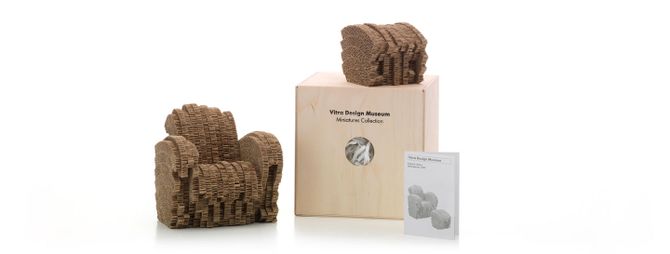
Miniatures Collection - Little Beaver
Frank Gehry, 1986
Gehry chose a different method, which gave birth to sturdy cardboard furniture like carboard sculptures: »One day I look in my office at a pile of corrugated cardboard, the material I normally used to make architecture models, and I began to experiment with it, to stick it together and to cut it into shape with a hand saw and a penknife«. Following his »Easy Edges« from 1972, a series of extraordinarily sturdy cardboard furniture with a smooth surface, from the end of the 1970s onwards Gehry once again devoted his attention to the use of corrugated cardboard as a material for making furniture.
»Experimental Edges« was the name given to unusually expansive armchairs and easy chairs with a rough, ragged- looking surface. Strips of thick cardboard usually used as the filling for door leafs were sawn or cut vertically to the corrugation lines and fashioned into solid volumes of varying shapes. Using this method, single items or small series of furniture were created, which were both furniture sculptures and surprisingly comfortable chairs and sofas.
Informations
| Titre | Langue | File | |
|---|---|---|---|
| Fiche Produit | DE | PDF, 786 kB | Télécharger |
Miniatures Collection
Depuis plus de 20 ans, le Vitra Design Museum reproduit en miniature les jalons de l'histoire du design de mobilier de sa propre collection. La Miniatures Collection englobe toute l'histoire du mobilier industriel – de l'historicisme et de l'Art Nouveau au Bauhaus et à la Nouvelle Objectivité, du Radical Design et du Postmodernisme à nos jours. Les chaises sont reproduites à l'échelle un sixième et reproduisent fidèlement l'original historique jusqu'au moindre détail de conception, de matériau et de nuance de couleur. Cette précision des détails s'applique aussi aux nervures du bois, à la reproduction des vis ou aux méthodes minutieuses de la fabrication artisanale. Ces miniatures sont non seulement de précieux objets de collection, mais également un support pédagogique pour les universités, les écoles de design et les architectes.